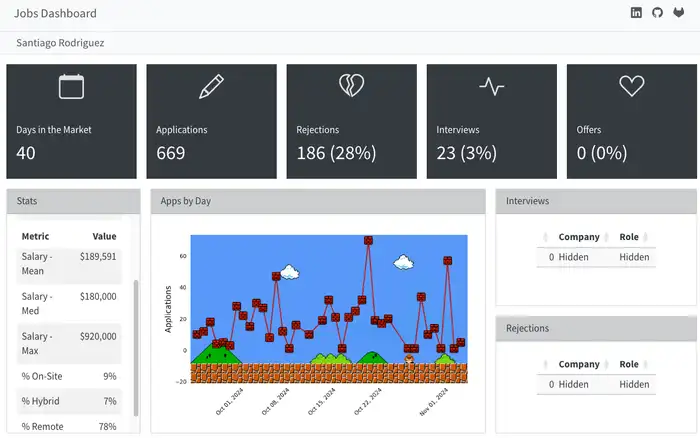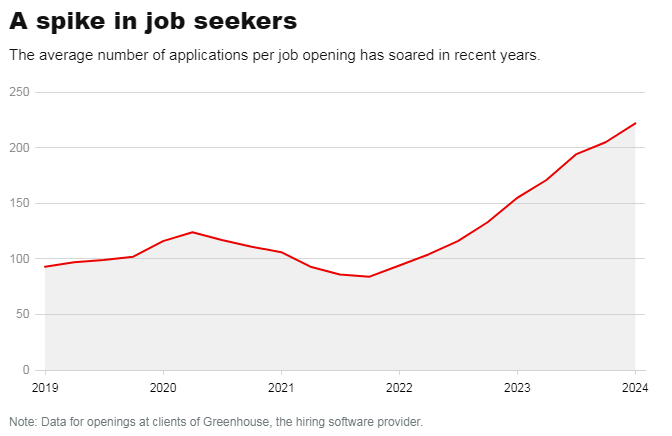Tech jobs are mired in a recessionWhite-collar hiring is in a huge slump. Here’s who’s being hit the hardest.

In January, Jon Bach got laid off as a director at eBay, where he had worked for 13 years. He loved his job, so he was disappointed. But he didn’t panic. The unemployment rate was near a five-decade low, and he had 30 years of experience in the tech industry. How hard could it be to find another job?
Pretty hard, it turned out. After applying for 135 openings, Bach has received 91 nonresponses, 42 rejections, two callbacks — and zero offers. “I don’t know what’s going on,” he says. “I’ve been doing this for a minute, and I’ve proven my value. And then you apply to one place, two places, 10 places, 50 places, 135 places. And you go, ‘Am I the guy I think I am?'”
By all the standard economic measures, America’s labor market looks fine. But ask white-collar professionals who are actually looking for a job, and they’ll tell you horror stories that are eerily similar to Bach’s. As I wrote last spring, that’s because the job market has essentially split into two distinct tiers. Even though hiring has held up well for lower-earning workers, it has plunged for people earning six figures or more. We’re in the midst of a white-collar recession.
Now, new data from LinkedIn — which tracked how often its users landed new jobs — shows which white-collar jobs are being hit the hardest. Some of them are the usual suspects in a downturn. You don’t need recruiters when you’re not recruiting, so hiring in human resources has slumped by 28% since 2018. Hiring in marketing, another department that’s often the first to lose its budget in leaner times, is down 23%.
But the most surprising feature of the job freeze is the pullback in tech. Hiring has plunged 27% in IT, 32% in quality assurance, and 23% in product management. In Bach’s field of program and project management, recruitment has slumped 25%. Even more surprisingly, engineering, which was long considered recession-proof, is down 26%. That kind of cutback in coders was long unthinkable in Silicon Valley, which treated programmers like rare minerals — so scarce that they needed to be preserved at all costs, regardless of how the economy was faring.

On the flip side are the professions that are holding up well. Military and protective services, a category that includes security guards, is down only 6%. Community and social services is down by only 3%. And healthcare, which is battling an acute staffing shortage fueled by an aging population and extraordinary levels of burnout on the front lines, is actually up 10%. You can see the same winners and losers on hiring platforms like Indeed: Since the pandemic, job postings for physicians and physical therapists have surged more than 80%, while those for software developers, data analysts, data scientists, and IT operations have declined by 20% or more.
“We have not seen the hiring slowdown everywhere,” says Kory Kantenga, an economist at LinkedIn. “But there are particular areas where it’s been very dramatic.”
Why has tech slammed the brakes on hiring? One reason is that tech companies, panicked by the Great Resignation that followed the pandemic, hired way too many professionals — leaving them with a glut of staff when the economy hit the skids. LinkedIn, which compared recruitment in 2018 to 2022, found that post-pandemic hiring spiked 89% for product managers, 79% for HR professionals, and 43% for engineers. When employers realized that they’d gone overboard, some resorted to mass layoffs to slash their headcounts. But most have taken a gentler route, implementing hiring freezes to slowly shrink their ranks by voluntary attrition.
Another reason tech companies are hiring fewer professionals is that their existing employees are opting to stay put. “One of the things we hear repeatedly is that candidates are looking for stability,” says Jenny Diani, a senior director of global technical recruiting at Autodesk, a leading software provider. “Candidates are being much more careful.” Visier, an HR software provider, reports that so far this year, voluntary turnover at its tech clients is under 20% — down from almost 27% in 2022. That means a company that wants to maintain a head count of 10,000 employees would need to hire 720 fewer professionals this year.
AI may also be playing a role in the hiring freeze. With tools like ChatGPT enabling tech workers to complete tasks more quickly, employers may see less of a need to increase head count. Nowhere is this productivity gain more evident than in coding: In an early study of an AI coding copilot, AI-assisted programmers were 56% faster than programmers working alone. Google recently boasted that more than a quarter of its new code is now being generated by AI.
“It’s not like you’re going to lay off a whole team,” says Jon Stross, a cofounder of Greenhouse, one of the biggest providers of hiring software. “But maybe we don’t have to grow quite as fast because we can automate more things and be more efficient. My guess is there are folks who are trying to make that happen.”
To make matters worse, changes in the way companies hire people are making the job freeze feel even more terrible than the numbers indicate. Several job seekers I spoke with told me their searches have been “slow” — which is putting it mildly. In mid-2021, according to Greenhouse, it took its clients an average of 52 days to make a hire. In the first quarter of this year, searches were dragging out to 66 days.
The slowdown in decision-making is a bit of a paradox. Given all the qualified candidates on the market right now, you’d think companies would have an easier time making a selection. But weirdly, the seemingly infinite supply of candidates makes them want to review even more applications before they make a decision. “In the recruiting world, we call it See More Disease,” says Diani, who is juggling three times as many job applications at Autodesk as she did during the Great Resignation. “We really need to coach our managers that even in this market, people with highly qualified, in-demand skills aren’t going to be sitting around forever.”

Santiago Rodriguez, a data scientist, built a dashboard to track the progress of his job search.
What shocks job seekers the most, though, is how many roles they have to apply for just to get a few measly callbacks. The 135 applications that Bach submitted might seem crazy high, but these days it’s actually the new norm. Santiago Rodriguez, a data scientist, told me he had applied to 669 positions — so many that he built an online dashboard to track his progress. Like the diligent statistician he is, he plans to analyze the data to see which versions of his résumé are generating a higher success rate.
It doesn’t help that job candidates, desperate to land a new role, are responding to the hiring slowdown by applying to every job in sight. LinkedIn has an “Easy Apply” button that makes it easy to flood the market with applications, and AI-powered services will even mass-apply to jobs for you. It makes sense for individual job seekers to maximize their chances by applying widely. But the more everyone piles on, the harder it gets for anyone to stand out. In the first quarter of this year, job openings at Greenhouse’s clients received an average of 222 applications — almost three times as many as at the end of 2021. “It’s exacerbated by everyone in this arms race applying to so many jobs that companies are just overwhelmed with applicants,” says Stross. “And so they don’t get back to people.”

For job seekers, being ghosted makes the process feel downright dehumanizing. “There’s so much angst,” says Stross. “Like: ‘I need a job and I can’t get anybody to look at my résumé.'”
The good news is, some data suggests that we’re already past the worst of the white-collar recession. At the end of last year, according to the industry group CompTIA, companies posted only 144,000 new tech roles. That has now rebounded to 223,000 openings — and is starting to approach the pre-pandemic level of 322,000 jobs. “We’re slowly, slowly recovering,” says Art Zeile, the CEO of Dice, a tech job board. The hope is that in the new year, with the election over and a couple more interest-rate cuts under the economy’s belt, white-collar employers will regain their appetite to start hiring again.
“I’m hopeful,” Bach told me. “I think a lot of people like me are eager to get back to work, to show companies that we’re worth taking a chance on. If you take a risk on me, I’ll show you that I’m worth it.”






